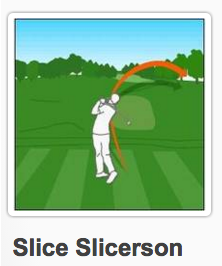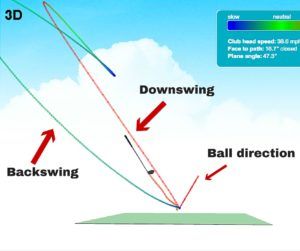
The golf slice is probably the most common swing problem that players face. Without the proper assistance it can be a serious issue that robs the player of both distance and accuracy.
One of the issues with chronic slicers is that what they think will solve the problem actually makes it worse. It can be terribly frustrating.
Since there are so many slicers out there, it’s not shocking to find all kinds of articles, products, and videos that offer the cure. Personally, I don’t think most of them identify the underlying issue. What they offer is merely a band-aid.
I decided to speak with someone who can help golfers understand what is really happening when you slice the ball. While there is no such thing as an absolute fix for any swing problem, my goal was to get an honest explanation of why the slice is occurring, and what you can do to fix it.
So I got in touch with Chris O’Connell to have a discussion about the slice. Chris is the co-founder of the Plane Truth, which is a swing philosophy that he and his mentor Jim Hardy founded. Their core belief can be summed up by the following quote:
The sole purpose of the golf swing is to produce a correct repetitive impact. The method employed is of no significance as long as it is correct and repetitive.
Chris has been recognized numerous times as one of the top instructors in the country. He works with all levels of players, and has been Matt Kuchar’s swing coach for almost 10 years, along with several other PGA Tour players.
Chris believes that the slice is not terribly complicated to fix once a golfer understands the core issue. That’s what I’ll be discussing in this article.
Incomplete remedies
I hope to clear up a few things for anyone that has been suffering from the slice. If you do some brief research online you’ll come across several common tips.
They include:
- Try strengthening your grip
- Close the clubface at impact
- “Release” the club (I still don’t know what that means)
While these concepts might have helped some golfers cure their slice, they actually don’t address the issue of why you are slicing.
If it were as easy as strengthening your grip, then there would be nobody slicing to begin with!
Understanding the core issue
One vital thing we can’t escape in golf is simple physics. I’m going to try to keep this explanation as simple as possible.
There are two main elements that largely impact the direction of your ball flight on any swing, and they both have to do with what occurs at impact. Not on your takeaway, not at the top of your swing, or with your grip; literally at the moment the club is coming into contact with the ball.
They are:
- How open or closed your clubface is
- The path of the club
Most people assume that the reason they slice is because they have the clubface open at impact, and most of the solutions are focused on finding a way to get it more closed. While this might be partially true, this is not the complete reason your ball is curving from left to right.
This is why teaching players to simply close their clubface does not always fix the problem.
The reason your ball is curving from left to right is because of your club path. Your club is coming across the ball from an outside to inside path, which you can see in this picture.

Your clubface position determines where your ball will start, but your club path has a huge influence on the shape of your shot. What percentage this actually is can be put to an endless debate.
This is exactly why there are all kinds of slices. There are those that start left of your target and then come across. Others will start out straight and then head to the right. Worst of all is the slice that starts right and goes even further right!
All of these variations occur because of the combination of the clubface position and direction. Where the slice starts relies on whether the clubface is open, square, or closed at impact. But a large reason why it is slicing is because of the club path.
Many players try to fix the problem by aiming even more to the left, but this actually can make it worse because that setup will further exaggerate the out-to-in swing path.
So how does Chris actually fix someone’s slice?
A look at a slicer
Let’s first take a look at the swing of someone who is a chronic slicer. We will keep this golfer anonymous, and refer to him as Slice Slicerson.

We had him use a Swingbyte to chronicle what a slice swing looks like, and as a way to illustrate some of the key issues. Here is a look at his swing plane.

You can see that he has the classic over the top move. This is certainly not the reason why everyone slices, but it has a large influence on this golfer. The club plane starts on a very inside path, and at the top of his swing he comes over the top and has a very steep plane to the ball.
The key thing here is the the path of his club is moving from outside to the inside at impact. This is where Chris believes the solution lies.
The Fixes
Let me start by saying there is no one way to fix a slice. When Chris O’Connell works with a student who is suffering from the slice, his first course of action is to figure out the main reason that is causing the club path to move from outside to in.
It could be in a player’s setup, backswing, or downswing. This is exactly why it’s irrational to assume you can just change a person’s grip to fix their slice. Every golfer is unique, and they will each have different solutions to this issue.
The concept of fixing the slice is foreign to most players because their instinct is to keep swinging further to the left to solve it, but it’s actually the opposite of what fixes the slice. You actually need to start swinging to the right, which is a bit scary for players because they are terrified of the whole idea of the ball going to the right!
Setup
For setup issues Chris has seen great success by changing where a player’s shoulders are aimed. Where their hips and feet are pointed is not necessarily the problem.
Because most players who slice are scared of losing the ball to the right, their shoulders are aimed to the left of the target at setup.By getting their shoulders pointing more towards the target, or even to the right of the target it can help solve the club path issue. Additionally, some players often have the ball too far up in their stance, and by moving it back it helps as well.
So for certain chronic slicers, just by addressing their setup, the problem is solved because the club path will take care of itself just by changing the alignment of their body.
Swing
If the setup isn’t necessarily the issue, then it’s time to take a look at the path of a player’s swing.
In most cases, Chris sees chronic slicers who have a poor position at the top of their swing. Their swings are generally too steep, which we saw with Slice Slicerson before.
In order to fix someone who is slicing because of his or her swing plane, he generally finds that teaching the exact opposite move through exaggeration will solve the issue.
To put it simply, you need to learn how to get the club face to come on an in-to-out path, or have a more round swing. This usually leads to the other side of the issue, eliminating the slice and actually producing a draw.
While this is not the only solution to fixing a golf slice, it works for many players. I can speak from personal experience as someone who used to have a terribly steep swing that resulted in many shots going to the right. The moment I decided to have a more inside to outside swing path my game completely changed for the better, and I mostly hit a draw now.
So you can say that this solution is kind of a “fight fire with fire” fix. You eliminate your outside to inside club path by doing the complete opposite, and learn to come from the inside.
If you keep your swing plane on a more inside path, you have your best chance of getting rid of that left to right ball flight that you so badly despise.
Homework for your golf slice
I want to reiterate once again that what has been discussed is not the only solution to fixing a slice. Every player is different, and will respond to different mental and physical cues.
Your best chance of solving the slice is working with an instructor that can come up with a custom solution for you. Personally, I believe understanding the core issue of your club path is the best way to arrive at the solution.
However, if you are someone who doesn’t have the time or money to work with a teaching pro, there are a few ways you can figure out what your swing plane looks like.
The first way is to just take a video of your swing. See if you can figure out what is going on with your club path. Additionally, you can work with a swing analyzer like Swingbyte to actually see the 3d path of your swing, and get some key stats on the club path. Their new swing coach feature can help you with this process, and recommend some drills. You'll be able to measure any progress you have with trying to either limit your out-to-in swing path.
Once you see what you’re doing, and you understand the underlying issue, a light might just go off.
Try working on a more round swing. It actually could be just like Chris’ student Matt Kuchar. Exaggerate a more inside swing during your practice sessions to feel what the other side of the fence feels like.
Great visual cues to work with are alignment sticks like these. If you can have them aligned on the inside-to-outside path, you can start to see where you want your clubface to travel before it gets to the ball.
When you address this core issue, then your slice might just go away for good.
We care about the protection of your data Read our Privacy Policy